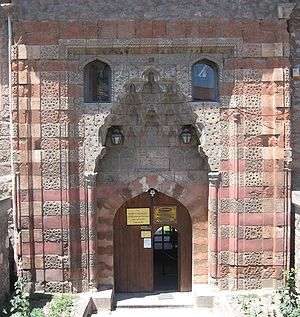Pervâne

Mu'in al-Din Sulaiman Parwana (Persian: معین الدین سلیمان پروانه), better known as Pervane (Persian: پروانه) was a Persian[1] statesman, who was for a time (especially between 1261–1277) a key player in Anatolian politics involving the Seljuk Sultanate of Rûm, the Mongol Ilkhanate and the Mamluks under Baybars.
Biography
Mu‘in al-Din Suleyman was the son of Muhadhdhab al-Din Ali al-Dailami, an Iranian from Kashan,[2] who served as the vizier to the Seljuq Sultan Kaykhusraw II in 1243 at the time of the Battle of Köse Dağ. Raised in a time of trouble after the Battle of Köse Dağ and having received a good education, Suleyman Pervane become commander of Tokat, and later Erzincan. He was appointed, by Mongol commander Bayju's recommendation, as chamberlain to the Konya palace of Seljuks sultan of Rûm, then vassals of the Mongols. He married Kaykhusraw's widow Gürcü Hatun and became the undisputed master of the declining state, making a name as a great intriguer. His title Pervâne means "personal aide of the sultan"[3]
After Kaykhusraw’s death and the ensuing dispute among his sons for the throne, the Pervâne supported Kilij Arslan IV and succeeded in having him declared as the successor. In the same period, he also took Sinop and twelve surrounding castles from the Empire of Trebizond and the region was accorded to him and his family as an iqta. His growing power made him worry that the sultan Kilij Arslan IV might want to eliminate him and he took the initiative by having the sultan strangled in Aksaray in 1265. The throne was succeeded by Kilij Arslan IV's minor son Kaykhusraw III (1265–1283).
During the Mamluk-Ilkhanid War and especially after the Mamluk hand had strengthened under Baybars, Pervâne's policy was characterized by multiple allegiances, all at the same time wishing to keep all his options open. According to Ibn Shaddad, when Baybars came to Syria in 1275, Pervâne played a pivotal role in dissuading him from his plans for invading the Anatolian heartland and directed him rather towards raids in the Armenian Kingdom of Cilicia, persuading him to leave the territories of his sultanate to the following year. But neither did he enjoy the Ilkhan Abagha's full confidence and the successes of Baybars had brought insipient anti-Mongol feelings among Seljuk notables, led by the Seljuk governors of Diyarbekir, Harput and Niğde, to the fore.
In 1277, Baybars entered the Seljuk sultanate and on 18 March, overcame the Mongol army in Elbistan, while Pervâne, who was in command of the Seljuk contingent expected by both Baybars and the Mongols, took flight to Tokat along with the young sultan. Baybars made a triumphal entry into Kayseri on 23 April and then returned to Syria. At the news of his troops' defeat, Abaqa hastened to Anatolia (July 1277) and sternly punished the Seljuk Turks, sources citing massacres of tens of thousands of people. Deeming him responsible for Baybars's foray into Anatolia, Abaqa also had Pervâne killed on 2 August 1277.
The story that the Abagha forced his subjects to eat the flesh of the Pervâne has its origin in Armenian history of Hetoum.[4]
His son Mehmed Bey took over the family possessions around Sinop and pursued a prudent policy of allegiance to the Mongols, which was also pursued under his son Mesud Bey's period as Bey. Mesud Bey was kidnapped by the Genoese in 1298 and was held for a heavy ransom. The last representative of the Pervane's line was probably the Gazi Chelebi, a notable pirate who ruled Sinop in the first decades of the 14th century.
Monuments

Several foundations of the Pervâne survive. In Sinop the Alaeddin Camii stands on the site of the former cathedral, which sometime after 1214 was converted into a mosque by Kayqubad I. The present structure was built de novo by the Pervâne in A.H. 666 (1267-68 C.E.).[5] The nearby Alâiye Medrese, sometimes called the Pervâne Medrese, was completed the same year.[6] In Tokat he built the so-called Gök Medrese in 1277. Originally founded as a hospital and medical school, the building now houses a museum. A nearby Seljuq style hamam is attributed to him although no inscription survives. There is another mosque of the Pervâne in Merzifon.
Recently the archaeological remains of a medrese founded by the Pervâne came to light within the compound of the closed bazaar of Kayseri. The medrese was partially excavated in 2002.[7]
See also
References
- ↑ Donzel, E. J. van (1 January 1994). Islamic Desk Reference. BRILL. p. 290. ISBN 90-04-09738-4.
Muin* al-Din Sulayman Parwana: de facto ruler of the Saljuq state of Rum in Anatolia during most of the Mongol Protectorate; d. 1277. Of Persian stock, he attempted to maintain stability both amongst the Turkish emirs and between them and the ever-increasing number of Mongols resident on Anatolian soil. He is said to have enjoyed a close relationship with Jalal al-Din Rumi.
- ↑ E. J. Brill's First Encyclopedia of Islam, p. 704 Google Books
- ↑ Bosworth, Clifford Edmund: The new Islamic Dynasties, Edinburgh University Press 1996; S. 230
- ↑ limited preview George Lane (2003). Early Mongol Rule in Thirteenth-Century Iran ISBN 0-415-29750-8. Routledge.
- ↑ Anthony Bryer and David Winfield, The Byzantine Monuments and Topography of the Pontos, vol. 1, (Washington D.C.: Dumbarton Oaks, 1985) 75.
- ↑ Bryer and Winfield, Byzantine Monuments, p. 72
- ↑ Seda Çalışır Hovardaoğlu. (full text and photos) "Pervâne Bey Medresesi olarak adlandırılan yapının ve Kayseri Kapalıçarşısı'nın korunması yönünde alınan kararlar ve değerlendirilmesi (The decisions taken for the protection of Kayseri closed bazaar and Pervâne Bey Medrese)" Check
|url=value (help) (PDF) (in Turkish). Erciyes University.
Books
- (limited preview) Reuven Amitai-Preiss (1995). Mongols and Mamluks: The Mamluk-Ilkhanid War, 1260-1281 ISBN 0-521-46226-6. Cambridge University Press.
- (limited preview) René Grousset (translated by N. Walford) (1970). The Empire of the Steppes: A History of Central Asia ISBN 0-8135-1304-9. Rutgers University Press.